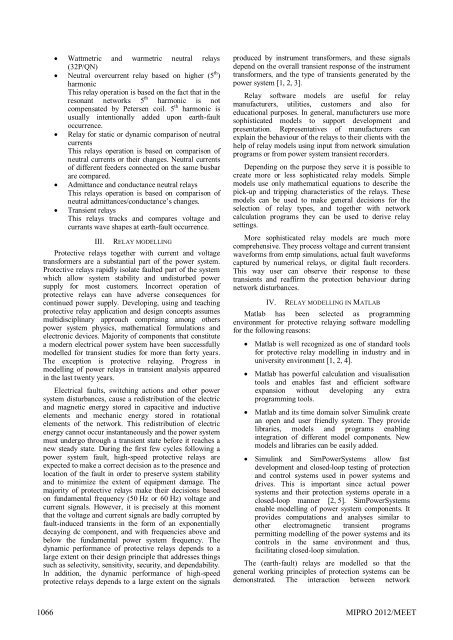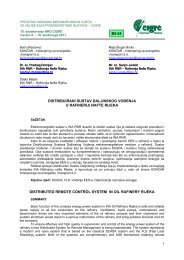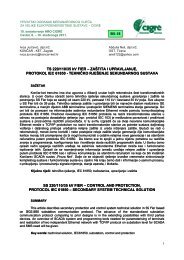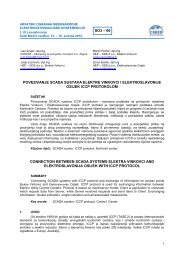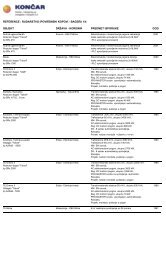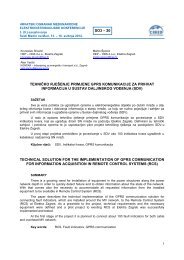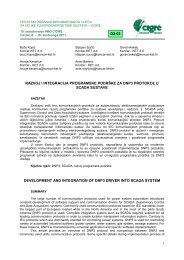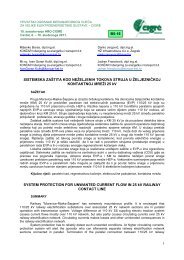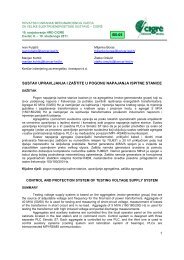Protection relay software models in interaction with power system simulators
Protection relay software models in interaction with power system ...
Protection relay software models in interaction with power system ...
- No tags were found...
Create successful ePaper yourself
Turn your PDF publications into a flip-book with our unique Google optimized e-Paper software.
Wattmetric and warmetric neutral <strong>relay</strong>s<br />
(32P/QN)<br />
Neutral overcurrent <strong>relay</strong> based on higher (5 th )<br />
harmonic<br />
This <strong>relay</strong> operation is based on the fact that <strong>in</strong> the<br />
resonant networks 5 th harmonic is not<br />
compensated by Petersen coil. 5 th harmonic is<br />
usually <strong>in</strong>tentionally added upon earth-fault<br />
occurrence.<br />
Relay for static or dynamic comparison of neutral<br />
currents<br />
This <strong>relay</strong>s operation is based on comparison of<br />
neutral currents or their changes. Neutral currents<br />
of different feeders connected on the same busbar<br />
are compared.<br />
Admittance and conductance neutral <strong>relay</strong>s<br />
This <strong>relay</strong>s operation is based on comparison of<br />
neutral admittances/conductance’s changes.<br />
Transient <strong>relay</strong>s<br />
This <strong>relay</strong>s tracks and compares voltage and<br />
currants wave shapes at earth-fault occurrence.<br />
III.<br />
RELAY MODELLING<br />
Protective <strong>relay</strong>s together <strong>with</strong> current and voltage<br />
transformers are a substantial part of the <strong>power</strong> <strong>system</strong>.<br />
Protective <strong>relay</strong>s rapidly isolate faulted part of the <strong>system</strong><br />
which allow <strong>system</strong> stability and undisturbed <strong>power</strong><br />
supply for most customers. Incorrect operation of<br />
protective <strong>relay</strong>s can have adverse consequences for<br />
cont<strong>in</strong>ued <strong>power</strong> supply. Develop<strong>in</strong>g, us<strong>in</strong>g and teach<strong>in</strong>g<br />
protective <strong>relay</strong> application and design concepts assumes<br />
multidiscipl<strong>in</strong>ary approach compris<strong>in</strong>g among others<br />
<strong>power</strong> <strong>system</strong> physics, mathematical formulations and<br />
electronic devices. Majority of components that constitute<br />
a modern electrical <strong>power</strong> <strong>system</strong> have been successfully<br />
modelled for transient studies for more than forty years.<br />
The exception is protective <strong>relay</strong><strong>in</strong>g. Progress <strong>in</strong><br />
modell<strong>in</strong>g of <strong>power</strong> <strong>relay</strong>s <strong>in</strong> transient analysis appeared<br />
<strong>in</strong> the last twenty years.<br />
Electrical faults, switch<strong>in</strong>g actions and other <strong>power</strong><br />
<strong>system</strong> disturbances, cause a redistribution of the electric<br />
and magnetic energy stored <strong>in</strong> capacitive and <strong>in</strong>ductive<br />
elements and mechanic energy stored <strong>in</strong> rotational<br />
elements of the network. This redistribution of electric<br />
energy cannot occur <strong>in</strong>stantaneously and the <strong>power</strong> <strong>system</strong><br />
must undergo through a transient state before it reaches a<br />
new steady state. Dur<strong>in</strong>g the first few cycles follow<strong>in</strong>g a<br />
<strong>power</strong> <strong>system</strong> fault, high-speed protective <strong>relay</strong>s are<br />
expected to make a correct decision as to the presence and<br />
location of the fault <strong>in</strong> order to preserve <strong>system</strong> stability<br />
and to m<strong>in</strong>imize the extent of equipment damage. The<br />
majority of protective <strong>relay</strong>s make their decisions based<br />
on fundamental frequency (50 Hz or 60 Hz) voltage and<br />
current signals. However, it is precisely at this moment<br />
that the voltage and current signals are badly corrupted by<br />
fault-<strong>in</strong>duced transients <strong>in</strong> the form of an exponentially<br />
decay<strong>in</strong>g dc component, and <strong>with</strong> frequencies above and<br />
below the fundamental <strong>power</strong> <strong>system</strong> frequency. The<br />
dynamic performance of protective <strong>relay</strong>s depends to a<br />
large extent on their design pr<strong>in</strong>ciple that addresses th<strong>in</strong>gs<br />
such as selectivity, sensitivity, security, and dependability.<br />
In addition, the dynamic performance of high-speed<br />
protective <strong>relay</strong>s depends to a large extent on the signals<br />
produced by <strong>in</strong>strument transformers, and these signals<br />
depend on the overall transient response of the <strong>in</strong>strument<br />
transformers, and the type of transients generated by the<br />
<strong>power</strong> <strong>system</strong> [1, 2, 3].<br />
Relay <strong>software</strong> <strong>models</strong> are useful for <strong>relay</strong><br />
manufacturers, utilities, customers and also for<br />
educational purposes. In general, manufacturers use more<br />
sophisticated <strong>models</strong> to support development and<br />
presentation. Representatives of manufacturers can<br />
expla<strong>in</strong> the behaviour of the <strong>relay</strong>s to their clients <strong>with</strong> the<br />
help of <strong>relay</strong> <strong>models</strong> us<strong>in</strong>g <strong>in</strong>put from network simulation<br />
programs or from <strong>power</strong> <strong>system</strong> transient recorders.<br />
Depend<strong>in</strong>g on the purpose they serve it is possible to<br />
create more or less sophisticated <strong>relay</strong> <strong>models</strong>. Simple<br />
<strong>models</strong> use only mathematical equations to describe the<br />
pick-up and tripp<strong>in</strong>g characteristics of the <strong>relay</strong>s. These<br />
<strong>models</strong> can be used to make general decisions for the<br />
selection of <strong>relay</strong> types, and together <strong>with</strong> network<br />
calculation programs they can be used to derive <strong>relay</strong><br />
sett<strong>in</strong>gs.<br />
More sophisticated <strong>relay</strong> <strong>models</strong> are much more<br />
comprehensive. They process voltage and current transient<br />
waveforms from emtp simulations, actual fault waveforms<br />
captured by numerical <strong>relay</strong>s, or digital fault recorders.<br />
This way user can observe their response to these<br />
transients and reaffirm the protection behaviour dur<strong>in</strong>g<br />
network disturbances.<br />
IV.<br />
RELAY MODELLING IN MATLAB<br />
Matlab has been selected as programm<strong>in</strong>g<br />
environment for protective <strong>relay</strong><strong>in</strong>g <strong>software</strong> modell<strong>in</strong>g<br />
for the follow<strong>in</strong>g reasons:<br />
Matlab is well recognized as one of standard tools<br />
for protective <strong>relay</strong> modell<strong>in</strong>g <strong>in</strong> <strong>in</strong>dustry and <strong>in</strong><br />
university environment [1, 2, 4].<br />
Matlab has <strong>power</strong>ful calculation and visualisation<br />
tools and enables fast and efficient <strong>software</strong><br />
expansion <strong>with</strong>out develop<strong>in</strong>g any extra<br />
programm<strong>in</strong>g tools.<br />
Matlab and its time doma<strong>in</strong> solver Simul<strong>in</strong>k create<br />
an open and user friendly <strong>system</strong>. They provide<br />
libraries, <strong>models</strong> and programs enabl<strong>in</strong>g<br />
<strong>in</strong>tegration of different model components. New<br />
<strong>models</strong> and libraries can be easily added.<br />
Simul<strong>in</strong>k and SimPowerSystems allow fast<br />
development and closed-loop test<strong>in</strong>g of protection<br />
and control <strong>system</strong>s used <strong>in</strong> <strong>power</strong> <strong>system</strong>s and<br />
drives. This is important s<strong>in</strong>ce actual <strong>power</strong><br />
<strong>system</strong>s and their protection <strong>system</strong>s operate <strong>in</strong> a<br />
closed-loop manner [2, 5]. SimPowerSystems<br />
enable modell<strong>in</strong>g of <strong>power</strong> <strong>system</strong> components. It<br />
provides computations and analyses similar to<br />
other electromagnetic transient programs<br />
permitt<strong>in</strong>g modell<strong>in</strong>g of the <strong>power</strong> <strong>system</strong>s and its<br />
controls <strong>in</strong> the same environment and thus,<br />
facilitat<strong>in</strong>g closed-loop simulation.<br />
The (earth-fault) <strong>relay</strong>s are modelled so that the<br />
general work<strong>in</strong>g pr<strong>in</strong>ciples of protection <strong>system</strong>s can be<br />
demonstrated. The <strong>in</strong>teraction between network<br />
1066 MIPRO 2012/MEET


